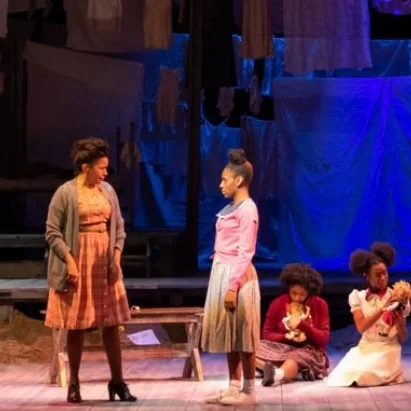"Bluest Eye," a powerful meditation on racism, ugliness, is something to behold
By Mal Vincent
March 14, 2019
The Virginian-Pilot
Why do we call a dandelion a weed?
The question, simplistic as it may seem, is at the heart of Lydia R. Diamond’s dramatization of Toni Morrison’s first novel, “The Bluest Eye,” on stage at the Wells Theater.
Why are we so eager to label everything and everyone? “The Bluest Eye,” about an African-American girl who seeks to please a world that dehumanizes her, raises such questions in poetic terms.
Those who attempt to stage Morrison’s heralded works, with their introspection and shifts in time, do so at their own peril. Khanisha Foster directs a cast that is up to the task, in terms of both energy and emotion. With the exception of a finale that feels rushed, they compellingly push the narrative forward.
Similarly to “The Color Purple,” the central horror in "Bluest Eye" is the rape and impregnation of an African-American girl by her alcoholic father.
The overall villain is a white culture that gives no outlet for pride or hope for the central character, Pecola, the rape victim who asks the question about dandelions. An undercurrent in this play is its examination of beauty, and African-American characters display their own prejudices via “colorism” as they correlate value and skin shades.
The setting is rural Ohio, during the Depression in 1941.
Pecola, who has dark skin, worships Shirley Temple, would like to dance and have blonde curls like her and wants most of all to have blue eyes. Another character boasts of seeing the movie “Imitation of Life” five times and admires the girl who “passed for white” in its plot. A mother wants her hair done like Hedy Lamarr’s. The hopes are hopes of another world – a seemingly forbidden world.
Self-humiliation. Lack of self-worth. Being declared "ugly" can be a life sentence. Who decides?
Two white villains in the play are only heard; they are represented visually as two flashlight beams illuminating Pecola's father, as a youth, and the girlfriend they force him to have sex with while they watch.
This, we are asked to realize, is a link to his later brutality. Indeed, we are asked to fill other motivational gaps as the play condenses a complex novel. This is not a play for the lazy.
Notably, the father's motivation is explored more deeply than that of any other character, yet he remains vague. Beethovan Oden brings a befuddlement to the character that suggests social oppression, but can not explain the atrocity. Perhaps nothing could.
The three actresses who play the young girls are the saving forces of the production, bringing a natural energy and youthful force that give the evening the humanity that the audience so desperately needs to get through it. Tabatha Gayle, as Pecola, and Djimon Armani and Ja’Keetrius Woods, as her two friends, are superb.
The other outstanding performance is given by Donna Simone Johnson as Pecola’s mother – tough love personified.
The most chilling moment of the evening, among many, comes when Pecola's mother comforts the white child of her employers while pushing away her daughter.
Director Foster stages part of it in silhouette in a way that heightens the distance between the mother and Pecola. The scenes of rape and a violent fight between Pecola's parents are staged as slow-motion, stylistic dance – a move that does nothing to soften their horror.
Josafath Reynoso's set is decorated by massive hangings of washed laundry – more decorative than creative. David Castaneda’s lighting is a marvelous work of stagecraft that keeps much isolated. The play would have worked better without an intermission. Mood, once captured, is difficult to re-capture.
The murky character of the soothsayer known as Soaphead seems to cry out for bravura and eccentricity, but is rather lackluster as portrayed by Levonte Herbert.
Soaphead seems to have no purpose until he puts the last straw onto Pecola's back. She goes to him, asking that he give her blue eyes. He tricks her into harming a dog that he hates because it's ugly. Did he know that she felt a special love for it because of their shared "ugliness"?
Gayle plays the scene beautifully, though it is difficult to take.
The script makes her descent into madness feel too quick – a push-the-button effect that contributes to the finale seeming rushed.
“The Bluest Eye” is not a pretty story but it is intriguing, and so amazingly balanced that it proves live theater’s ability to spark meaningful debate. It is a rare happening.


